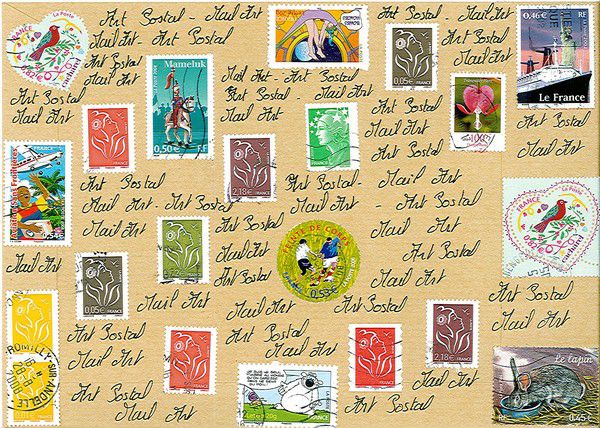Limited Vocabulary
With my limited vocabulary,
Back pain, tendency to sloth and other frailties,
I still have much to say
And say it,
It arriving daily
As a post from nowhere, sender
Totally unknown,
No stamp or postmark on it.
Limit:
One can only work within it,
Trust that what’s within
Is valid, potent and convincing.



Mail art, a populist movement centered on sending small-scale works through the postal service, initially developed out of the Fluxus movement in the 1950s and 60s, though the American collagist Ray Johnson ("New York's most famous unknown artist") began experimenting with art in the mail in 1943; his posting of instructions and soliciting of activity from his recipients began in the mid-1950s with the mailing of his "moticos," small, irregularly shaped works incorporating fragments from popular culture, most notably commercial logos and images from fan magazines. His first known piece of mail directing a recipient to "please send to..." [someone else] dates from 1958; the phrases "please add to and return", "please add and send to,"and even "please do not send to" followed. In 1962, Ed Plunkett called Johnson's endeavors the New York Correspondence School, a moniker Johnson adopted but sometimes intentionally misspelled it as "correspondance." Johnson proclaimed that correspondence is "a way to convey a message or a kind of idea to someone which is not verbal; it is not a confrontation of two people. It's an object which is opened in privacy, probably, and the message is looked at.... You look at the object and, depending on your degree of interest, it very directly gets across to you what is there."
ReplyDeleteThe movement gained importance when members of the international group of avant garde artists known as Fluxus began participating: Robert Filliou coined the term the "Eternal Network" that has become synonymous with mail art; in 1963 Robert Watts created Stamp Dispenser artistamps (artist-created stamps); in 1965 Ben Vautier created The Postman's Choice postcards with a different address on each side. In 1970 Johnson organized the first significant public exhibition of the mail art genre, staged at the Whitney Museum in New York. Media include postcards, paper, collages of found or recycled images and objects, rubber stamps, and paint, as well as music, sound art, poetry, or anything that can be put in an envelope and sent via post. The genre promoted an egalitarian way of creatvity that circumvented official art distribution and approval systems such as the art market, museums, and galleries. The mail art philosophy of openness and inclusion is exemplified by the "rules" included in invitations (calls) to postal projects: a mail art show has no jury, no entry fee, and no censorship; all works are exhibited, often in alternative spaces such as private apartments, municipal buildings, and shop windows. In the 1970s, the practice of mail art grew considerably, providing a cheap and flexible channel of expression for cultural outsiders. It was particularly widespread where state censorship prevented a free circulation of alternative ideas. Johnson punned that "mail art has no history, only a present," and mail artists have created parody art movements (such as neoism and plagiarism) that challenge notions of originality, while shared pseudonymous names Monty Cantsin and Karen Eliot were proposed for serial use by anyone. A sub-group of envelope art had its genesis in the Grateful Dead Ticket Service, a mail order servie created by the American rock band to help their fans avoid the high fees generated by national ticket services, and fans started decorating their envelopes with art. Lettering, whether handwritten or printed, is integral to mail art, as are recordings of poetry and prose. Performance art has also been a prominent facet, particularly since the advent of mail art meetings and congresses; filmed performances are communicated via DVD and movie files over the internet. Mail art is considered art once it is dispatched. By the 1980s several festivals, meetings, and conventions were held, including the Inter Dada Festivals organized in California and the Decentralized Mail Art Congress of 1986. But in the 1990s, as postal rates increased, mail artists began migrating towards the worldwide web and other forms of digital communication.
ReplyDelete